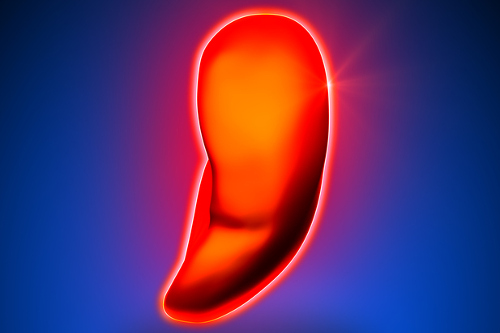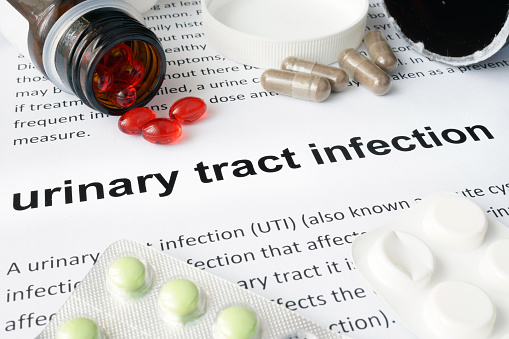 You could have an enlarged spleen right now without even knowing it. Many cases go undiagnosed as there may not be any major symptoms to cause alarm. As a vital defender against infections and viruses, the spleen can work overtime before signaling an issue.
You could have an enlarged spleen right now without even knowing it. Many cases go undiagnosed as there may not be any major symptoms to cause alarm. As a vital defender against infections and viruses, the spleen can work overtime before signaling an issue.
It is usually the size of the fist; however, it increases in size when it is in trouble or detects a serious health concern. We will learn why it becomes enlarged, what to watch for, and how to treat any spleen issues.
First, we must understand the function of our spleen. Located in the upper left abdominal region under the rib cage, this brown, oval-shaped organ belongs to our lymphatic system. Its primary role is to filter blood as it destroys damaged cells. It manages and stores excess red blood cells and platelets and produces antibodies to prevent infections, viruses and harmful pathogens from attacking our body.
Sometimes, the spleen cannot manage all toxins or demand of white blood cells and becomes enlarged. An enlarged spleen is not cause for concern, but the reason behind it may be.
What Causes an Enlarged Spleen?
Known as splenomegaly, an enlarged spleen may be temporary and can be caused by a variety of diseases and infections or by overworking to keep up the demand of its use. The most common enlarged spleen causes include:
 Liver disease such as cirrhosis
Liver disease such as cirrhosis- Viral infection such as mononucleosis
- Alcohol or drug abuse
- Cancers such as leukemia, a cancer of the blood, or lymphoma, a cancer of tissue such as Hodgkin’s Disease
- Bacterial infections such as endocarditis or syphilis
- Hemolytic anemia
- Parasitic infection such as malaria
- Pressure or blood clots in veins within the spleen or liver
- Metabolic disorders
There are also several other causes such as:
- Cysts
- Injury that causes trauma to a body such as in contact sports
- Abscess caused by a bacterial infection
- Inflammatory conditions such as lupus, rheumatoid arthritis, or sarcoidosis
Symptoms of an Enlarged Spleen
As mentioned, an enlarged spleen does not always present physical symptoms, or at least ones that do not warrant medical attention. There is no direct spleen pain. It is usually discovered during a routine exam. For those that experience symptoms, they can vary from mild to severe.
 Pain and tenderness in the upper left abdominal region
Pain and tenderness in the upper left abdominal region- Indigestion
- Fatigue
- Satiety after a light snack or small meal
- Pain during deep breaths
- Jaundice symptoms
- Unsuspected weight loss
- Pain that travels from the stomach to the left shoulder
- Anemia symptoms
- Frequent bruising and bleeding
- Recurring infections of the ear, urinary tract, sinus or respiratory system
If you have severe pain in your upper left abdominal cavity, especially when taking deep breath, it is crucial you seek immediate medical attention.
The danger of having an enlarged or damaged spleen is the risk of contracting infections or illness as your defense system will be down. The spleen would not be able provide essential functions such as producing and protecting white and red blood cells for energy nor would it provide platelet production for blood clotting.
Enlarged Spleen: Diagnosis and Treatment
An enlarged spleen is diagnosed by your doctor during a physical exam. Usually, your spleen cannot be detected during a routine exam; however, if enlarged, your doctor will be able to feel it. Several tests can confirm the diagnosis.
1. Magnetic Resonance Imaging
An MRI shows the blood flow through the spleen. There is no required preparation for an MRI.
2. Ultrasound or CT Scan
An ultrasound or a computerized tomography scan detects the spleen size and whether it is obstructing other organs. For the spleen, there is no preparation for an ultrasound, but you may need to fast from food for a period of time before the test.
3. Blood Test
The number of red and white blood cells, as well as your platelet count, will be discovered with a complete blood count test. There is no required preparation for the test.
4. Additional Tests
Once you are diagnosed with an enlarged spleen, the next step is to discover the reason behind it. You may need additional tests such as liver function tests or a bone marrow exam. These tests take a closer look at the actual cells.
A bone marrow exam could involve a biopsy, where a sample is taken from the pelvis region. A bone marrow aspiration may also be done separately or at the same time. This entails a sample of the liquid in the marrow being removed. Both involve a needle inserted into the bone after you are given a general or local anesthesia.
Enlarged Spleen Treatments
Once it is discovered why your spleen has increased in size, treatment can begin and depends on the cause. Bacterial infections can be cleared up with antibiotics.
If the cause of your enlarged spleen cannot be determined and you have no symptoms, the doctor may suggest a “watchful waiting” period. Your doctor will monitor you for the next several months for any presentation of symptoms.
Symptoms present with no cause may lead your doctor to suggest you have your enlarged spleen removed surgically, known as a splenectomy. It would be examined afterwards for any signs of lymphoma. This is a big decision to make as yes, you can live without your spleen; however, you are then more susceptible to serious infections in the future. Sometimes radiation is suggested instead of surgery to shrink the spleen.
There are ways to protect your enlarged spleen. To prevent it from rupturing:
- Avoid hard physical activities such as contact sports.
- Always wear a seat belt to prevent any injury to your spleen in the event of an accident.
- Ensure your vaccinations are up to date as your risk for infections is greater.
The spleen is a vital organ in maintaining regular functions within our body. An enlarged spleen can be managed and treated. It is caused by various invaders such as diseases, infections, or other harmful events. You may not have any serious symptoms to alert you, but your doctor will detect it with a physical exam. Treatments vary depending on the cause, with surgery being a last resort. You can live without your spleen, but without it, you would be at a greater risk for infections and disease. Talk to your doctor about any concerns or seek immediate medical attention if you experience severe pain in the upper left abdominal region.
Related:
- Is Stomach Flu (Gastroenteritis) Contagious? How Long Is Stomach Flu Contagious?
- What’s Behind Your Stomach Growling?
- Stomach Ulcer Diet: Foods to Eat and Avoid
Sources:
“Enlarged Spleen: Causes, Symptoms and Treatments,” Web MD; http://www.webmd.com/digestive-disorders/enlarged-spleen-causes-symptoms-and-treatments#1, last accessed February 3, 2017.
“Enlarged Spleen (Splenomegaly)” Mayo Clinic; http://www.mayoclinic.org/diseases-conditions/enlarged-spleen/home/ovc-20212739, last accessed February 3, 2017.
